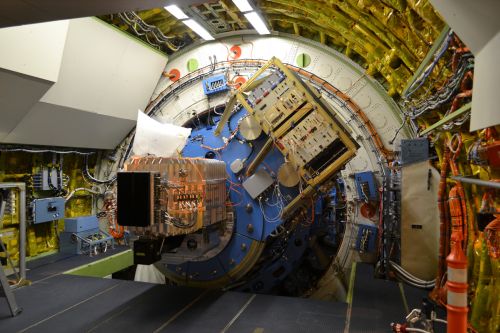Star Formation Region in the Orion Nebular investigated

The far-infrared-spectrometer FIFI-LS at the SOFIA telescope (copyright: DSI).
On its first scientific mission the far-infrared spectrometer FIFI-LS (Field-Imaging Far-Infrared Line Spectrometer) developed by a team led by the University of Stuttgart has explored the prominent star-forming region of the Orion Nebula. The instrument was flown on board the airborne observatory known as SOFIA (Stratospheric Observatory For Infrared Astronomy), a joint program of the National Aeronautics and Space Administration (NASA) and the German Aerospace Centre (DLR).
FIFI-LS was built at the University of Stuttgart's Institute of Space Systems (IRS) under the leadership of Alfred Krabbe. In November 2014, the instrument was shipped to NASA's Palmdale, California, facility to be prepared for operations on board SOFIA. Additionally the German SOFIA Institute (DSI) of the University of Stuttgart coordinates the operation of the flying observatory on behalf of the German partner.
Cooling of the gas is a requirement for star formation
The Orion Nebula is located about 1,300 light years from Earth, in the Milky Way Galaxy. This area of the sky is of high scientific interest, because it is one of the most active star-forming regions in our galaxy. Using FIFI-LS, astronomers want to investigate the Becklin-Neugebauer (BN) object, which is a molecular cloud that hosts young stars as well as dense gas which is still forming new stars.
A main requirement for this process is, that the “warm” gas in this region will cool down from about 100 K to about 10 K – only then the pressure inside the cloud drops and the gas density increases sufficiently enough in order to build stars. Elements like oxygen and carbon can drive this cooling process by emitting thermal energy from the inside of the cloud to the outside.
Leslie Looney, from University of Illinois and principal investigator for the Orion observations, will try to find out how these cooling processes work in detail. “Oxygen and carbon emit a considerable amount of cloud’s thermal energy at particular wave length, which we can monitor in a superb way with FIFI-LS,” said Looney. Currently SOFIA is the only observatory that can detect cosmic radiation at these far-infrared wavelengths.
In parallel to the cooling, the hot and young Trapezium stars of Orion heat the gas cloud. When this warmed-up and ionized gas hits cooler gas, it forms a shock front like the Orion bar. From the strength and the spatial distribution of the [OI] 63, 145 µm and [CII] 157 µm lines, Leslie Looney can investigate the actual relation between the cooling and the heating mechanisms. For example [CII] 157 µm could not be observed with any other observatory before. “The unique aspect of the FIFIU-LS data is the size of the map at this resolution,” the astronomer summarizes.
Astronomer and instrument builder Alfred Krabbe from IRS is also very glad: “I am really happy that FIFI-LS cooperated in such a great way with the SOFIA observatory and that we can now provide a new scientific instrument to the astronomical community. For the next observing cycle that will start in spring 2015, the team plans to do more observations on Orion in order to complete the now existing charts.
Detailed information to FIFI-LS
http://www.irs.uni-stuttgart.de/forschung/fifi-ls/index.html
Earlier FIFI-LS news
Erfolgreiche Inbetriebnahme von FIFI-LS (16. März 2014)
FIFI-LS wiord nach Kalifornien verschifft (12. November 2013)
Contact:
Dörte Mehlert
mehlert@dsi.uni-stuttgart.de
Tel.: +49 (0)711 – 685 69632
SOFIA, the “Stratospheric Observatory for Infrared Astronomy” is a joint project of the Deutsches Zentrum für Luft- und Raumfahrt e.V. (DLR; German Aerospace Centre, grant: 50OK0901) and the National Aeronautics and Space Administration (NASA). It is funded on behalf of DLR by the Federal Ministry of Economics and Technology based on legislation by the German Parliament the state of Baden-Württemberg and the Universität Stuttgart. Scientific operation for Germany is coordinated by the German SOFIA-Institute (DSI) of the Universität Stuttgart, in the USA by the Universities Space Research Association (USRA). The development of the German Instruments is financed by the Max Planck Society (MPG) and the German Research Foundation (DFG) an by the DLR.
Media Contact
All latest news from the category: Physics and Astronomy
This area deals with the fundamental laws and building blocks of nature and how they interact, the properties and the behavior of matter, and research into space and time and their structures.
innovations-report provides in-depth reports and articles on subjects such as astrophysics, laser technologies, nuclear, quantum, particle and solid-state physics, nanotechnologies, planetary research and findings (Mars, Venus) and developments related to the Hubble Telescope.
Newest articles

“Nanostitches” enable lighter and tougher composite materials
In research that may lead to next-generation airplanes and spacecraft, MIT engineers used carbon nanotubes to prevent cracking in multilayered composites. To save on fuel and reduce aircraft emissions, engineers…

Trash to treasure
Researchers turn metal waste into catalyst for hydrogen. Scientists have found a way to transform metal waste into a highly efficient catalyst to make hydrogen from water, a discovery that…

Real-time detection of infectious disease viruses
… by searching for molecular fingerprinting. A research team consisting of Professor Kyoung-Duck Park and Taeyoung Moon and Huitae Joo, PhD candidates, from the Department of Physics at Pohang University…





















